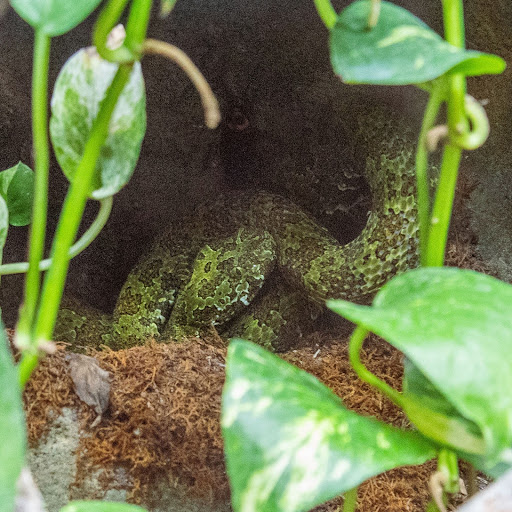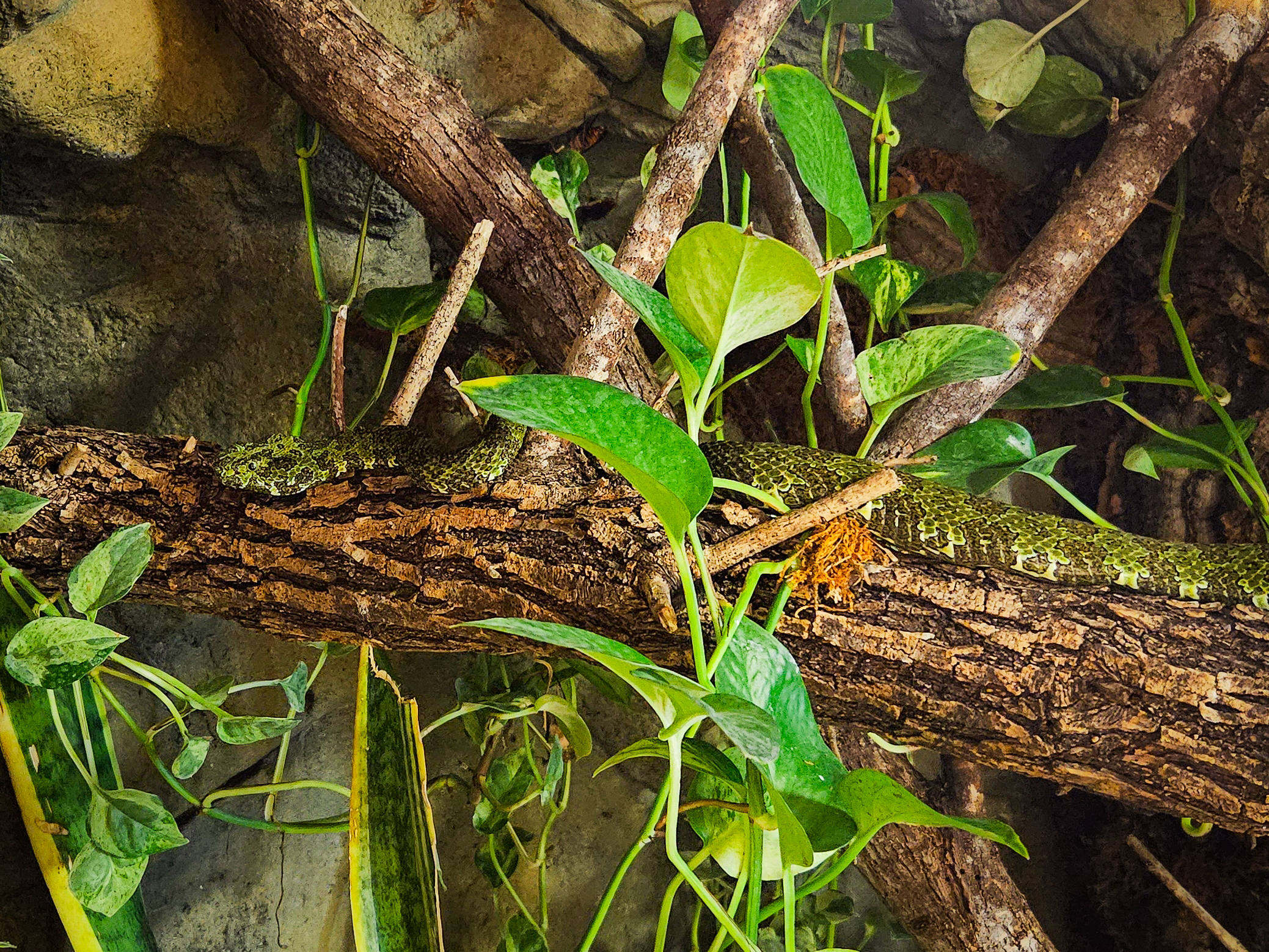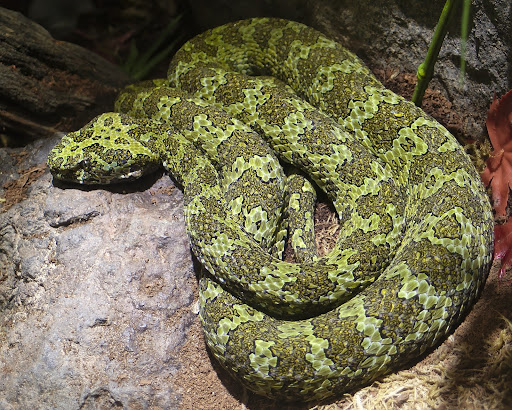Welcome to this month’s Snake of the Month spotlight at Animal World & Snake Farm Zoo! For May, we’re featuring one of the world’s rarest and most remarkable snakes: the Mangshan Viper. This elusive pit viper is unlike any other — it was only discovered in 1989, and fewer than 500 are believed to remain in the wild. With its striking green-and-brown mosaic pattern and fascinating behaviors, the Mangshan Viper is truly a unique jewel of the reptile world.
We also spoke with our Deputy Director, Jarrod Forthman, to get a closer look at what makes this species so impressive.
Curious to meet our Snake of the Month? Plan your visit today and see the Mangshan Viper in person!
Meet the Mangshan Viper
The Mangshan Viper (Protobothrops mangshanensis) is a venomous snake found only in a tiny area of southern China. It gets its name from the Mangshan (Mang Mountain) region in Hunan Province, where it was first identified, and can grow up to 7 feet long and weigh over 10 pounds — making it one of the largest vipers in Asia.
Its body is a brilliant mix of bright green and earthy brown blotches, providing excellent camouflage on the mossy forest floor. As Deputy Director Jarrod Forthman explains, “Its cryptic coloration makes for excellent camouflage, and that makes it fun for guests to attempt to find it in its very naturalistic enclosure.”

One especially fascinating feature is the bright white tip of its tail, which it uses to lure in prey — a hunting technique known as caudal luring (which we’ll discuss more here in a bit.) Few zoos in the world house this rare species, and we’re proud to offer guests the chance to see it up close here at Animal World & Snake Farm Zoo.
Behavior & Diet
In the wild, Mangshan Vipers are nocturnal ambush predators. By day, they remain still and hidden, blending into the forest undergrowth. Once night falls, they become active hunters—lying in wait along animal trails and using special heat-sensing pits near their eyes to detect the warmth of passing prey. When a rodent, bird, or frog wanders too close, the viper strikes with lightning speed, injects its venom, and then waits for the prey to succumb before swallowing it whole.
One of the Mangshan Viper’s most fascinating hunting strategies is called caudal luring, where it uses the white tip of its tail to mimic the movement of a worm or grub in order to attract curious prey. “Watching this species’ caudal luring is amazing,” says Deputy Director Jarrod Forthman. “They possess a whitish to bright yellow tail that mimics a worm. It’s so awesome watching them go ‘fishing’ for food as they wiggle their tail.”
In terms of diet, Mangshan Vipers typically consume small mammals, birds, and frogs in their natural environment. At Animal World & Snake Farm Zoo, our team provides a specialized diet designed to closely mirror what they would eat in the wild, helping keep the animal physically and behaviorally healthy.
Conservation & Why They Matter
The Mangshan Viper is not only a rare and remarkable reptile—it’s also endangered. With a population confined to a small mountain forest region in Hunan and Guangdong, China, this species is extremely vulnerable to habitat loss, illegal collection, and poaching. Today, scientists estimate that only 300 to 500 Mangshan Vipers remain in the wild. 
At Animal World & Snake Farm Zoo, we believe that education is key to conservation. “Just like many other snake species, the Mangshan Viper is critically endangered and needs help from people to ensure it survives and hopefully begins to thrive in the wild,” explains Jarrod Forthman, Deputy Director. “Snakes are the number one phobia on the planet, which means we have our work cut out for us educating people in an attempt to help them understand the role snakes play in the wild. Until people truly understand snakes, they won’t be looking out for their best interest. By caring for Mangshan Vipers and educating guests about them, zoos like ours contribute to a broader global conservation effort. “Hopefully through education and captive propagation, we are able to assist in the global effort to save this amazing snake species,” Jarrod adds.
Ultimately, conservation isn’t just about preserving a species—it’s about reshaping the way people think about snakes and their role in nature. “Just like all snakes, they deserve their place in the wild,” says Jarrod. “When left alone, they can live alongside humans safely and truly be appreciated for the amazing animals that they are.”

Come Meet Our Mangshan Viper
If you’ve never seen a Mangshan Viper up close, you’re in for a rare and unforgettable experience. At Animal World & Snake Farm Zoo, our Mangshan Viper lives in a carefully designed enclosure that replicates its mountainous forest habitat—with plenty of rocks, natural leaf litter, and areas to hide.
“We provide very naturalistic and bioactive enclosures for the Mangshan Vipers here at the zoo,” says Jarrod Forthman, Deputy Director. “That includes live plants, a clean-up crew of bugs, and misting and heating/cooling systems to replicate the high humidity and proper temperatures found in their natural environment.”
Caring for such a rare and sensitive species comes with challenges. “The biggest challenge,” Jarrod notes, “is trying to simultaneously replicate natural humidity, temperatures, photo periods, as well as the diet.” But for the Animal Care Team, it’s a challenge they take seriously to ensure the animal thrives.
When guests visit the exhibit, Jarrod hopes they see more than just a camouflaged predator. “I’d like folks to really appreciate their beauty and see past the myths that have given snakes such a bad reputation,” he says.
Bonus: 5 Kid-Friendly Facts About Mangshan Vipers
Looking for some fun facts to share with your kids or students? Here are five cool things about the Mangshan Viper that make it a must-see during your visit:
- They were only discovered in 1989!
This species was completely unknown to science until a little over 30 years ago. It’s like nature kept this incredible snake a secret for centuries. - Camouflage experts.
Mangshan Vipers blend in so well with mossy rocks and leaf litter that you might walk right past one in the wild and never know it. Keep your eyes peeled in their exhibit—it’s a game of hide and seek! - Tail like a worm? Yes!
These vipers use the white tip of their tail to mimic a worm and lure prey. As Deputy Director Jarrod Forthman says, “It’s so awesome watching them go ‘fishing’ for food as they wiggle their tail.” - Giant but gentle.
These snakes can grow as long as an adult person—up to 7 feet—and weigh over 10 pounds. But don’t worry, they aren’t aggressive and prefer to stay hidden. - Snake moms that guard their eggs.
Unlike most vipers, Mangshan Vipers lay eggs—and the mother stays to protect them until they hatch. That’s rare and impressive parenting in the reptile world!
Bring the whole family for a wild adventure at Animal World & Snake Farm Zoo – you might even catch our Mangshan Viper in action!
Final Thoughts: A Rare Encounter Worth Seeing
The Mangshan Viper is more than just a fascinating reptile—it’s a living reminder of how much of the natural world remains mysterious, endangered, and worth protecting. With fewer than 500 believed to remain in the wild, seeing one in person is a rare opportunity to connect with a species most people will never encounter.
At Animal World & Snake Farm Zoo, we’re proud to care for this incredible snake and to share its story with every guest who walks through our doors. By visiting, learning, and supporting conservation through education, you’re helping make a difference—one snake at a time.
Come visit us this May to meet our Snake of the Month, the Mangshan Viper, and discover the wild side of conservation.

